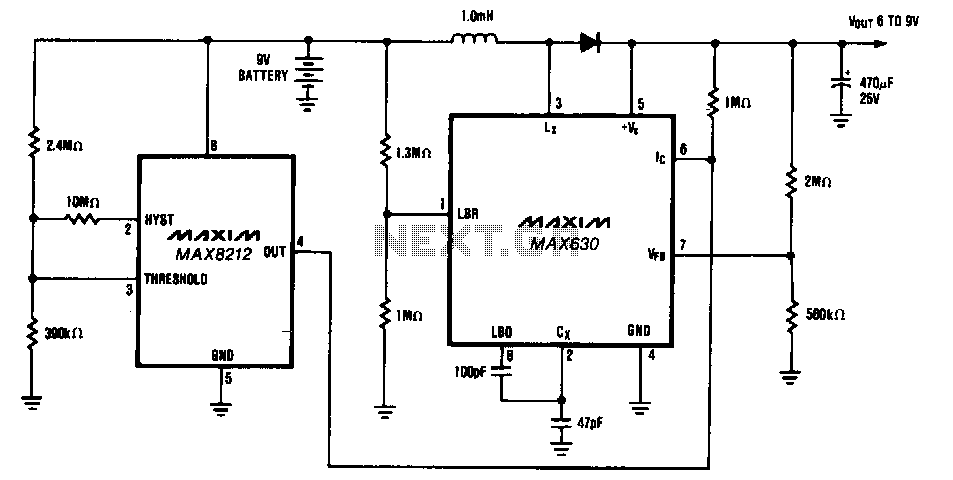
9-V-battery-life-extender

The circuit provides a minimum output of 7 V until the 9-V battery voltage drops below 2 V. When the battery voltage is above 7 V, the MAX630's IC pin is low, placing it in shutdown mode, which consumes only 10 nA. As the battery voltage decreases to 7 V, the output of the MAX8212 voltage detector increases. The MAX630 then regulates the output voltage to maintain it at 7 V. The low battery detector (LBD) functions to reduce the oscillator frequency when the battery voltage reaches 3 V, thereby enhancing the circuit's output current capability. Additionally, it is important to note that this circuit, whether or not it incorporates the MAX8212, can deliver 5 V from 4 alkaline cells. The initial voltage is approximately 6 V, and the output is sustained at 5 V even when the battery voltage drops below 2 V.
The described circuit effectively manages battery voltage levels to ensure a stable output voltage, utilizing key components such as the MAX630 and MAX8212. The MAX630 is a low dropout linear regulator designed to provide a fixed output voltage while minimizing power consumption. In this application, it operates in a shutdown mode when the battery voltage exceeds 7 V, significantly reducing power draw to 10 nA.
The MAX8212 serves as a voltage detector, monitoring the battery voltage and signaling the MAX630 to maintain the output at 7 V once the voltage falls below this threshold. This regulation is crucial for applications requiring consistent voltage levels, particularly in battery-operated devices where power efficiency is paramount.
Furthermore, the low battery detector (LBD) is an integral feature that responds to decreasing battery voltage. When the voltage drops to 3 V, the LBD reduces the oscillator frequency, which in turn increases the output current capability of the circuit. This adjustment is vital for maintaining functionality as the battery discharges, ensuring that the circuit can still supply adequate power to connected loads.
The circuit's versatility is highlighted by its ability to generate a stable 5 V output from a configuration of 4 alkaline cells, even when the total battery voltage dips below 2 V. Initially, the voltage from the cells is around 6 V, and the circuit is designed to regulate this down to a consistent 5 V output. This characteristic makes it suitable for a variety of low-power applications where reliable voltage regulation is required, especially in portable electronic devices that rely on battery power.Circuit provides a minimum of 7 V until the 9-V battery voltage falls to less than 2 V. When the battery voltage is above 7 V, the MAX630"s IC pin is low, putting it into the shutdown mode which draws only 10 nA. When the battery voltage falls to 7 V, the MAX8212 voltage detector"s output increases. The MAX630 then maintains the output voltage at 7 V. The low battery detector (LBD) is used to decrease the oscillator frequency when the battery voltage falls to 3 V, thereby increasing the output current capability of the circuit.
Note that this circuit, with or without the MAX8212, can be used to provide 5 V from 4 alkaline cells. The initial voltage is approximately 6 V, and the output is maintained at 5 V even when the battery voltage falls to less than 2 V.
The described circuit effectively manages battery voltage levels to ensure a stable output voltage, utilizing key components such as the MAX630 and MAX8212. The MAX630 is a low dropout linear regulator designed to provide a fixed output voltage while minimizing power consumption. In this application, it operates in a shutdown mode when the battery voltage exceeds 7 V, significantly reducing power draw to 10 nA.
The MAX8212 serves as a voltage detector, monitoring the battery voltage and signaling the MAX630 to maintain the output at 7 V once the voltage falls below this threshold. This regulation is crucial for applications requiring consistent voltage levels, particularly in battery-operated devices where power efficiency is paramount.
Furthermore, the low battery detector (LBD) is an integral feature that responds to decreasing battery voltage. When the voltage drops to 3 V, the LBD reduces the oscillator frequency, which in turn increases the output current capability of the circuit. This adjustment is vital for maintaining functionality as the battery discharges, ensuring that the circuit can still supply adequate power to connected loads.
The circuit's versatility is highlighted by its ability to generate a stable 5 V output from a configuration of 4 alkaline cells, even when the total battery voltage dips below 2 V. Initially, the voltage from the cells is around 6 V, and the circuit is designed to regulate this down to a consistent 5 V output. This characteristic makes it suitable for a variety of low-power applications where reliable voltage regulation is required, especially in portable electronic devices that rely on battery power.Circuit provides a minimum of 7 V until the 9-V battery voltage falls to less than 2 V. When the battery voltage is above 7 V, the MAX630"s IC pin is low, putting it into the shutdown mode which draws only 10 nA. When the battery voltage falls to 7 V, the MAX8212 voltage detector"s output increases. The MAX630 then maintains the output voltage at 7 V. The low battery detector (LBD) is used to decrease the oscillator frequency when the battery voltage falls to 3 V, thereby increasing the output current capability of the circuit.
Note that this circuit, with or without the MAX8212, can be used to provide 5 V from 4 alkaline cells. The initial voltage is approximately 6 V, and the output is maintained at 5 V even when the battery voltage falls to less than 2 V.